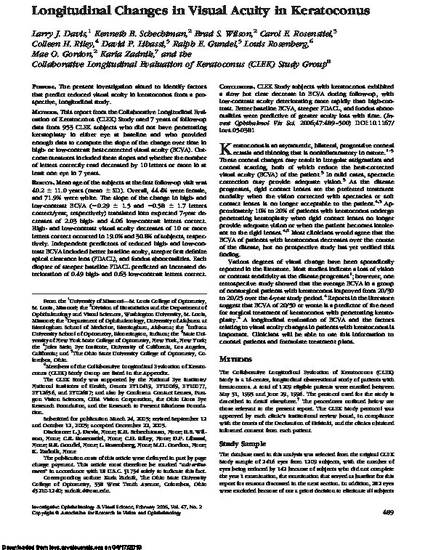
Article
Longitudinal Changes in Visual Acuity in Keratoconus
Investigative Ophthalmology & Visual Science
(2006)
Abstract
Purpose. The present investigation aimed to identify factors that predict reduced visual acuity in keratoconus from a prospective, longitudinal study.
Methods. This report from the Collaborative Longitudinal Evaluation of Keratoconus (CLEK) Study used 7 years of follow-up data from 953 CLEK subjects who did not have penetrating keratoplasty in either eye at baseline and who provided enough data to compute the slope of the change over time in high- or low-contrast best-corrected visual acuity (BCVA). Outcome measures included these slopes and whether the number of letters correctly read decreased by 10 letters or more in at least one eye in 7 years.
Results. Mean age of the subjects at the first follow-up visit was 40.2 ± 11.0 years (mean ± SD). Overall, 44.4% were female, and 71.9% were white. The slope of the change in high- and low-contrast BCVA (−0.29 ± 1.5 and −0.58 ± 1.7 letters correct/year, respectively) translated into expected 7-year decreases of 2.03 high- and 4.06 low-contrast letters correct. High- and low-contrast visual acuity decreases of 10 or more letters correct occurred in 19.0% and 30.8% of subjects, respectively. Independent predictors of reduced high- and low-contrast BCVA included better baseline acuity, steeper first definite apical clearance lens (FDACL), and fundus abnormalities. Each diopter of steeper baseline FDACL predicted an increased deterioration of 0.49 high- and 0.63 low-contrast letters correct.
Conclusions. CLEK Study subjects with keratoconus exhibited a slow but clear decrease in BCVA during follow-up, with low-contrast acuity deteriorating more rapidly than high-contrast. Better baseline BCVA, steeper FDACL, and fundus abnormalities were predictive of greater acuity loss with time.
Disciplines
Publication Date
February, 2006
DOI
10.1167/iovs.05-0381
Citation Information
Edward Bennett, Larry J. Davis, Kenneth B. Schechtman, Brad S. Wilson, et al.. "Longitudinal Changes in Visual Acuity in Keratoconus" Investigative Ophthalmology & Visual Science Vol. 47 (2006) p. 489 - 500 Available at: http://works.bepress.com/edward-bennett/20/
